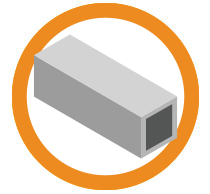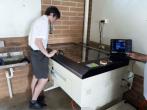
Indoor air quality plays a crucial role in maintaining a healthy and comfortable living environment. Since we spend a significant amount of time indoors, especially in Winter, it is essential to be aware of the benefits of air filtration.
Two of the most effective filters are HEPA (High-Efficiency Particulate Air) and Carbon filters. How do the work?

HEPA Filters
HEPA filters are constructed using fine fibres arranged in a dense web-like pattern. The primary function of HEPA filters is to capture and trap microscopic particles as small as 0.3 micrometres in diameter, such as dust, pollen, pet dander, mould spores, and other airborne pollutants.

The fibres in HEPA filters (represented above by blue bars) trap dirt and dust particles in three ways. Impact occurs when larger airborne particles directly embed themselves into the filter fibres. Some are caught as they flow along in the moving airstream, move too close to a fibre and are trapped by interception. At lower air speeds, some are trapped by diffusion (when randomly moving dust and air particles crash into one another, causing them to be pushed into the filter fibres).
These processes combine to make HEPA filters are highly efficient, capable of capturing up to 99.97% of particles present in the air.
However, they are designed to target particulate matter and are less effective against gaseous pollutants, volatile organic compounds (VOCs), and odours.
Carbon Filters
Carbon filters, on the other hand, excel in removing odours, chemicals, and gases from the air. They are composed of activated carbon, a form of carbon processed to increase its surface area and adsorption capacity. This allows carbon filters to attract and trap a wide range of gaseous pollutants through a process called adsorption.
Adsorption is the adhesion of gas or liquid molecules to the surface of a solid. The activated carbon in a filter provides an extensive network of pores and crevices that attract and retain various molecules. These carbon filters effectively capture harmful gases like formaldehyde, benzene, ammonia, and volatile organic compounds (VOCs) that may be present in indoor air.
In combination with HEPA filters, carbon filters can enhance the overall air quality by removing both particulate matter and gaseous pollutants.

SmartAir
BST Health is the proud Australian distributor of SmartAir, the premium, and most cost-effective Air Purifiers on the market. Their range starts with the diminutive QT3 (which is mobile and can sit on your office desk or even your car), all the way to the Blast MkII (a powerhouse of a unit that can clean the air of any large room). Contact the Clean Air experts today www.bsthealth.com.au







